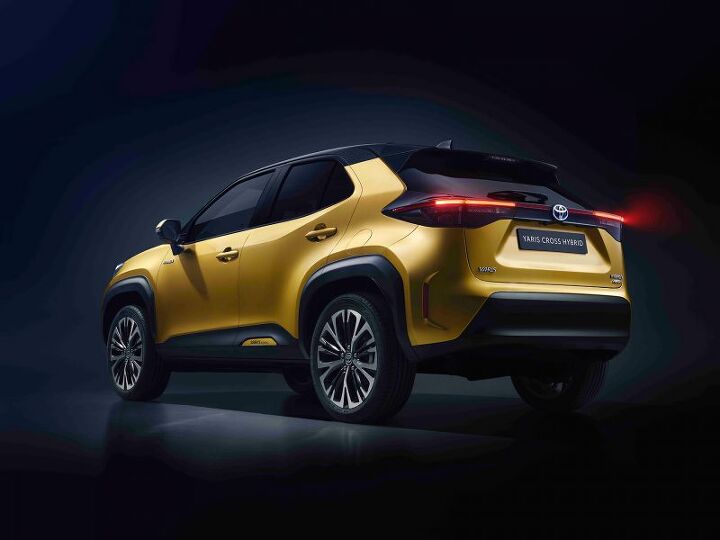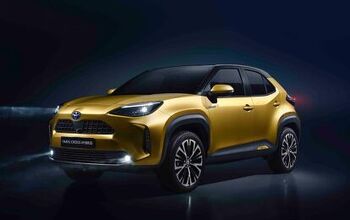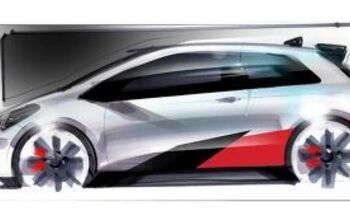Toyota Yaris Bulks Up, Becomes Yaris Cross

You won’t like it when it’s angry. Actually, you might, as the Toyota Yaris Cross small crossover seems to have not a mean bone in its body.
Boasting just three cylinders underhood whether in gas-only or hybrid guise, the Yaris Cross is what happens when enthusiasm for subcompact hatchbacks starts to wane, but the automaker doesn’t want to spoil what it already has going for it in that segment.
Riding atop the smallest TNGA platform, this Yaris undercuts the already subcompact C-HR in size by a significant degree, providing a new, cheaper stepping stone to Toyota’s broad range of utility vehicles. The model goes on sale in Japan later this year, with European customers getting a crack at in in mid-2021.
It follows on the heels of the next-generation Yaris revealed overseas late last year, but don’t hold your breath if you’re living in North America. The automaker didn’t mention additional markets. Indeed, Toyota’s Yaris strategy is very different here, with our Yaris not being a Yaris at all, but a facelifted Mazda 2.
The previous-generation, non-Mazda Yaris soldiered on until last year, with sales eventually shrinking to near zero. That said, there’s an argument to be made that, while the Yaris hatch fell out of favor among U.S. customers, a slightly upsized crossover-ish version might go over well. Size and interior volume could prove an issue, though. Remember that this is a smaller vehicle that the C-HR.
Instead, Americans might get an opportunity to get into a larger Corolla Cross in the near future. That model exists in trademark filings, and seems a better fit for the market.
So, Japanese and European buyers will get this. Powered by a 1.5-liter inline-three (with a six-speed manual or continuously variable automatic) or a hybrid drivetrain combining an Atkinson-cycle three-banger and an electric motor, the otherwise front-drive Yaris Cross offers available E-Four electric all-wheel drive. In that hybrid-only variant, the rear axle remains independent from the engine, powered solely by a rear electric motor.
[Images: Toyota]

More by Steph Willems
Latest Car Reviews
Read moreLatest Product Reviews
Read moreRecent Comments
- 1995 SC If the necessary number of employees vote to unionize then yes, they should be unionized. That's how it works.
- Sobhuza Trooper That Dave Thomas fella sounds like the kind of twit who is oh-so-quick to tell us how easy and fun the bus is for any and all of your personal transportation needs. The time to get to and from the bus stop is never a concern. The time waiting for the bus is never a concern. The time waiting for a connection (if there is one) is never a concern. The weather is never a concern. Whatever you might be carrying or intend to purchase is never a concern. Nope, Boo Cars! Yeah Buses! Buses rule!Needless to say, these twits don't actual take the damn bus.
- MaintenanceCosts Nobody here seems to acknowledge that there are multiple use cases for cars.Some people spend all their time driving all over the country and need every mile and minute of time savings. ICE cars are better for them right now.Some people only drive locally and fly when they travel. For them, there's probably a range number that works, and they don't really need more. For the uses for which we use our EV, that would be around 150 miles. The other thing about a low range requirement is it can make 120V charging viable. If you don't drive more than an average of about 40 miles/day, you can probably get enough electrons through a wall outlet. We spent over two years charging our Bolt only through 120V, while our house was getting rebuilt, and never had an issue.Those are extremes. There are all sorts of use cases in between, which probably represent the majority of drivers. For some users, what's needed is more range. But I think for most users, what's needed is better charging. Retrofit apartment garages like Tim's with 240V outlets at every spot. Install more L3 chargers in supermarket parking lots and alongside gas stations. Make chargers that work like Tesla Superchargers as ubiquitous as gas stations, and EV charging will not be an issue for most users.
- MaintenanceCosts I don't have an opinion on whether any one plant unionizing is the right answer, but the employees sure need to have the right to organize. Unions or the credible threat of unionization are the only thing, history has proven, that can keep employers honest. Without it, we've seen over and over, the employers have complete power over the workers and feel free to exploit the workers however they see fit. (And don't tell me "oh, the workers can just leave" - in an oligopolistic industry, working conditions quickly converge, and there's not another employer right around the corner.)
- Kjhkjlhkjhkljh kljhjkhjklhkjh [h3]Wake me up when it is a 1989 635Csi with a M88/3[/h3]
































Comments
Join the conversation
God that is hideous looking. I feel slightly ill.
Can we expect a GR version soon?